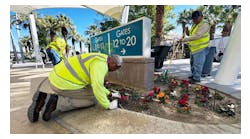Several weeks ago, major media outlets reported on an unscheduled airline landing due to an odor in the cabin that some were attributing to “passed gas”. While no one was hurt and many on the ground were later heard to say that it was a mechanical odor, whatever that is, it did cause our WTF (Way Too Freaky) alarm to go off in our headquarters. This MIFL (Methane Induced Forced Landing) event greatly concerns the IBT as several years ago, we took great pains to examine just such a possibility during our study of EBI (Explosive Body Implants). While EBI countermeasures never made it out of the lab into full production, one such study did result in the creation of a testing device to help prevent MIFL.
Code named SHAMU (Super Human Asphyxiate Mitigation Undertaking), this operation was directed at preventing would be terrorists from increasing the amounts of asphyxiates a person could produce from eating chemically enhanced beans, cabbage, cheese, soda, and eggs. By increasing the amount of asphyxiates a person or multiple people could produce in a thinner oxygen environment, such as at high altitude. This condition could result in dangerous levels of nitrogen and flammable methane being introduced in the cabin of an aircraft. In the right situations, this toxic level of asphyxiates could permanently impair or disable aircraft passengers. Our lab work proved that an average person can expel asphyxiates at the rate of 10 feet per second and that a person, who could flatulate continuously for 6 months and 9 days, could produce the effective gas of an atomic bomb. Taking the math further, we can work out that it would take nearly 56,160 people off-gassing simultaneously for 15 minutes to create the effects of an atomic bomb. Since even the most densely loaded A380 cannot hold anywhere near 56,160 people, the potential of creating a FLAT-BOMB (flatulence bomb) at 30,000 feet is impossible. These calculations for the SHAMU operation did result, however, in the industry’s first ever MED (Methane Evacuation Device).
The MED is vacuum pump technology that when inserted in a posterior docking port, just prior to boarding, will evacuate all trapped air thereby rendering inert each passenger as a possible toxic asphyxiate carrier. While the MED did exceptionally in trials, it was never advanced to the operational environment of an airport, in part due to difficulty in creating an acceptable “plug-n-play” port for each passenger and the potential to improperly dispose of the captured contaminate thereby contributing to global warming.
As we, as an industry, continue to work against the ever-evolving threats to the aviation system by those who would do us harm, the IBT continues their work to create devices to defeat threats that have not even been thought of yet. Due to overwhelming safety concerns, we are not at liberty to discuss future, unimagined threats nor mitigation devices to defend against these future undetermined threats. However, you can be sure, much like the MIFL above, our WTF response is always at the ready should the situation warrant.
Finally, the IBT has received many requests to study the mitigation efforts to combat “armrest” feet. We are currently in trials now for our Top Ten List of mitigating this corny and callus attitude of passengers from the seat behind you using your armrest as a foot stool.
Roddy is the Executive Vice President of Aviation at Suffolk where he is responsible for National Aviation Strategy, Pipeline Sourcing, and Tier Accounts. A 30 year aviation professional, he is an Architect with a Bachelors’ of Design from Texas Tech University. Roddy is the 2017 Board Chair of the Airport Consultants Council (ACC) and sits on the Board of Directors for the International Partnering Institute (IPI) as well as the International Association of Airport Executives (IAAE).







